Ph.D. Study
Research Activities in the Field of
MIMO Wireless Communication
Table of Contents [Toc]
Ph.D. Thesis
General
Information
Abstract
About the Author
Keywords
The Research Project
The MMSE-SQRD ASIC
The real-time 4x4 MIMO-OFDM
Testbed
WinTech'08 Live
Demonstration Preparation
WinTech'08 Live
Demonstration Contest
ISCAS'09 Live Demonstration
Contest
Testbed Deployment of the MMSE-SQRD
ASIC
Illustrating Material / Posters
Ph.D. Thesis
[Toc] [Top]
General Information
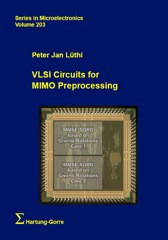 |
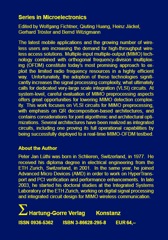 |
Peter Jan Lüthi,
VLSI Circuits for MIMO Preprocessing,
Hartung-Gorre, 2010, Ph.D.
dissertation, ETH Zurich, Zurich, Switzerland,
222 pages, € 64,00
ISBN-10: 3-86628-295-8
ISBN-13: 978-3-86628-295-7
Excerpt with ToC,
Ordering
Information |
Abstract
The latest mobile applications and the growing number of
wireless users are increasing the demand for high-throughput
wireless access solutions. Multiple-input multiple-output (MIMO)
technology combined with orthogonal frequency-division
multiplexing (OFDM) constitute today's most promising approach to
exploit the limited radio frequency resources in a highly
efficient way. Unfortunately, the adoption of these technologies
significantly increases the signal processing complexity, what
ultimately calls for dedicated very-large scale integration
(VLSI) circuits. At system-level, careful evaluation of MIMO
preprocessing aspects offers great opportunities for lowering
MIMO detection complexity. This work focuses on VLSI circuits for
MIMO preprocessing, with emphasis on QR decomposition-based
architectures, and contains considerations for joint algorithmic
and architectural optimizations. Several architectures have been
realized as integrated circuits, including one proving its full
operational capabilities by being successfully deployed to a
real-time MIMO-OFDM testbed.
About
the Author
Peter Jan Lüthi was born in Schlieren, Switzerland, in
1977. He received his diploma degree in electrical engineering
from the ETH Zurich, Switzerland, in 2001. In the same year, he
joined Advanced Micro Devices (AMD) in order to work on
HyperTransport and PCI verification and performance enhancements.
In late 2003, he started his doctoral studies at the Integrated
Systems Laboratory of the ETH Zurich, working on digital signal
processing and integrated circuit design for MIMO wireless
communication.
Keywords
MIMO preprocessing, V-BLAST, sorted QR decomposition (SQRD),
MMSE, Givens rotations, CORDIC, digital signal processing, VLSI
circuits, ASIC
The
Research Project [Toc] [Top]
The aim of the research project I was involved in during my
Ph.D. study was the design, implementation and demonstration of
suitable algorithms for MIMO wireless communication and its
assessment with respect to implementation complexity and
practical performance. Selected algorithms were implemented in a
real-time 4x4 MIMO-OFDM testbed and demonstrated under real-world
conditions.
In short, my activities in this research project generated the
following research contributions:
- Assessment of MIMO preprocessing algorithms, with focus on
V-BLAST and sorted QR decomposition (SQRD)
- Specification of suitable quality metrics for algorithm
optimizations with respect to fixed-point hardware
implementation
- Exploration of the VLSI design space including assessment
of finite-precision effects
- Design of different VLSI architectures for minimum mean
squared error (MMSE)-SQRD based on Givens rotations and the
modified Gram-Schmidt algorithm
- Integration of various MMSE-SQRD architectures as
application-specific integrated circuit (ASIC), including
characterization of circuit area, clock frequency,
computational throughput, power consumption, and energy
efficiency
- Testbed deployment of selected MMSE-SQRD circuits in order
to prove real-time operation under real-world conditions
The
MMSE-SQRD ASIC [Toc] [Top]
Here are few impressions of one of my application-specific
integrated circuits (ASIC), which implements an algorithm called
minimum mean squared error (MMSE) sorted QR decomposition
(SQRD).
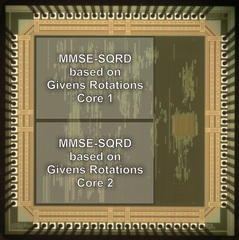 |
Chip micrograph of the dual-core
MMSE-SQRD ASIC based on Givens rotations in UMC 0.18um
1P/6M CMOS technology. Both cores operate on the same I/O
interface in an interleaved fashion and double the
performance compared to single core operation, without
incurring penalties due to I/O limitations.
|
 |
A tribute to the ingenious CORDIC
circuit invented in 1959 by Jack E. Volder and the powerful
and efficient Intel Core architecture being popular at the
time of engineering my ASIC: MMSE-SQRD V2 -
"CORDIC 2 Duo - Do More"
I hope, the legal department of Intel Corp. won't sue
me... |
 |
| ID of the MMSE-SQRD V2 ASIC:
ETHZ D-ITET DZ, umcL180 1P6M GII, IIS ETH10
09-Feb-08 |
The initial MMSE-SQRD ASIC was taped out on February 26, 2007,
in UMC 0.18um 1P/6M CMOS technology. The purpose of two ASIC
integrations in the same technology was to assess any differences
in physical integration and manufacturing concerning the maximum
clock frequency of the final circuits (post-layout timing vs.
actual silicon clock frequency).
The
real-time 4x4 MIMO-OFDM Testbed [Toc] [Top]
In the following, a brief overview of the 4x4 MIMO-OFDM
testbed with embedded real-time signal processing and MAC layer
handling is provided. In the end, the MIMO testbed was quite a
complex hardware-software architecture including FPGA and ASIC
resources, an embedded IBM PowerPC 405 RISC CPU (available as
hard macro cell in the XILINX Virtex-II Pro FPGAs) for handling
the MAC layer tasks, custom-designed 2.4 GHz RF circuitry
for wireless communication, and a Gigabit Ethernet device for
wired connectivity. Finally, we were able to stream movies and to
download files from the Internet across our real-time MIMO
prototyping system.
 |
| One terminal of the real-time 4x4
MIMO-OFDM testbed consisting of two XILINX Virtex-II
Pro (XC2VP70-5-ff1517) FPGAs, one XILINX Virtex-4
(XC4VSX55-10-ff1148) FPGA, and two MMSE-SQRD ASICs. Note
that every board carries its unique identifier such as
Mickey, Goofy, Donald, Dagobert, Gustav, Daisy, Minnie, and
Pluto. |
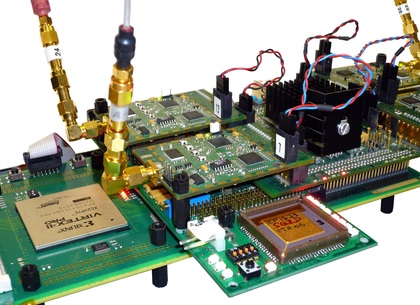 |
| Fully operational SQRD-based MIMO
preprocessing with two dual-core MMSE-SQRD ASICs in the
real-time 4x4 MIMO-OFDM testbed. One MMSE-SQRD ASIC is
visible in front, the second ASIC is located underneath the
two RF boards. The SQRD-based MIMO preprocessing resides in
between channel estimation and MIMO processing. |
 |
Partitioning of the real-time 4x4
MIMO-OFDM testbed across three FPGAs and three
different types of prototyping boards. The boards were
named 'Virtex-II Pro astonishing multi-purpose' (VAMP)
board, and accordingly, BAT and WING boards. The VAMP board
was in charge of all baseband signal processing and MAC
layer tasks, the BAT board handled the digital front-end
signal processing, and the WING boards performed wireless
transmission and reception at 2.4 GHz.
Not indicated here is the additional interface to the
SQRD-based MIMO preprocessing, which resides in between
channel estimation and MIMO processing and infers another
PCB and two MMSE-SQRD ASICs. |
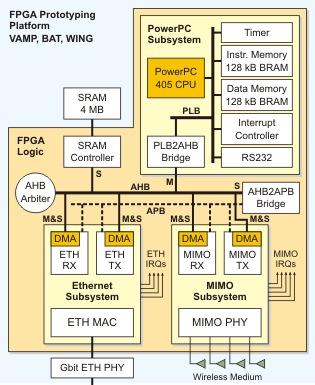
|
| System architecture of the real-time
4x4 MIMO-OFDM testbed with embedded MAC layer
processing and Ethernet connectivity. The embedded MAC
layer is processed within the PowerPC CPU running at
240 MHz, the Advanced High-performance Bus (AHB)
between CPU, Ethernet and MIMO subsystems is clocked at
80 MHz. |
WinTech'08 Live
Demonstration Preparation [Toc] [Top]
Having been invited to the third international workshop on
Wireless Network Testbeds, Experimental Evaluation and
Characterization (WiNTECH) and the associated live demonstration
contest at the ACM International Conference on Mobile Computing
and Networking (MobiCom) in San Francisco, CA, USA, we had to get
the testbed equipment ready for take-off.
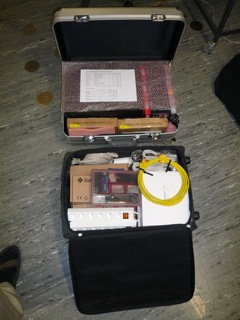 |
The entire MIMO prototyping system
consisting of three terminals in two suitcases (without
laptops) ready for departure to San Francisco, CA, USA, in
September 2008. With respect to customs and the mandatory
Carnet A.T.A., the customs officers at JFK International
Airport were very friendly and, due to temporal coincidence
with the first successful proton collisions in the
Large
Hadron Collider (LHR) at CERN, quite amused
that again some Swiss carry some obscure equipment, which
would potentially provoke the formation of another black
hole...
|
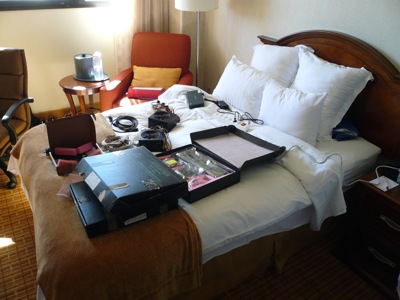 |
| Terrorists in a hotel room in San
Francisco? Not really - in fact MIMO testbed
preparations at its very beginning. Not a good time for a
nap... |
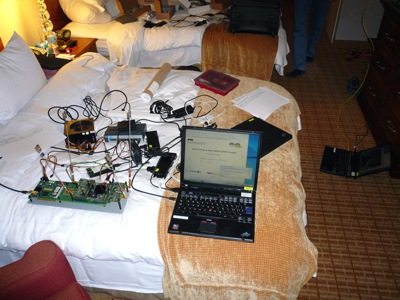 |
| Debugging a terminal of our real-time
MIMO-OFDM testbed: A missing jumper related to
received signal strength indication (RSSI) and frame
synchronization at one RF board caused several hours of
debugging work and impeded us from having
dinner... |
 |
| By chance, our hotel room happened
to change to a communications laboratory. Finally,
everything is working as expected, great! Hmm, no more
dinner... |
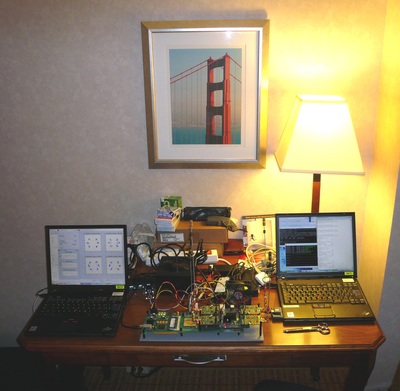 |
| Kind of a modern still life:
Late-night testbed preparation activities in a hotel room
in San Francisco, CA, USA, in order to get ready for next
day's live demonstration contest. On the left laptop
screen, you can see the constellation diagrams of
four-stream MIMO wireless reception using QPSK modulation.
The right laptop serves for observing and controlling the
MIMO testbed and the embedded MAC by means of a terminal
window connecting through RS232 to the embedded PowerPC CPU
in the prototyping system. Moreover, the right laptop acts
as server for video streaming using the VLC media player.
The displayed MIMO testbed terminal constitutes the access
point in this ad-hoc network. |
WinTech'08 Live Demonstration
Contest [Toc]
[Top]
At the time of the ACM WinTech'08 live demonstration contest
in September 2008, the MMSE-SQRD ASIC was not yet fully deployed
to the testbed in order to demonstrate advanced MIMO detection
schemes such as tree-search-based maximum likelihood (ML) or
near-ML detection schemes. Nevertheless, linear MIMO detection in
conjunction with four-stream MIMO transmission was fully
operational and ready for live demonstration. In the end, we
accomplished to win the second place in this live demonstration
contest.
 |
| Testbed setup at the ACM WinTech'08
live demonstration contest in San Francisco, CA, USA,
in late 2008: Three testbed terminals (1 access point, 2
stations) with 5 laptops demonstrating live video streaming
and full Internet access using four-stream MIMO wireless
communication. Well, during development and demonstration,
I've seen different parts of the movie 'Office Space' for
sure 100 times, but I never managed to see the entire movie
at once from the beginning to the end... |
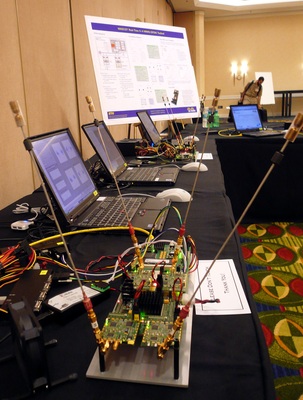 |
| The terminal configured as access
point of the real-time 4x4 MIMO-OFDM testbed at the
WinTech'08 live demonstration contest in San Francisco, CA,
USA. |
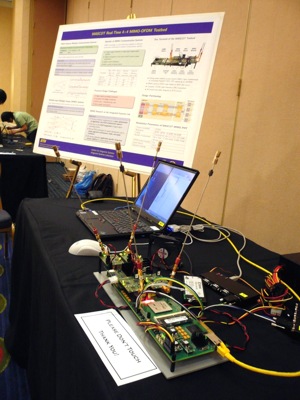 |
| The testbed terminal configured as
access point was attached through the
yellow Gigabit Ethernet cable to a laptop running
the VLC media player acting as server for live video
streaming. Additionally, the laptop was also connected
to the hotel's access point for providing full Internet
access to the wireless MIMO network. |
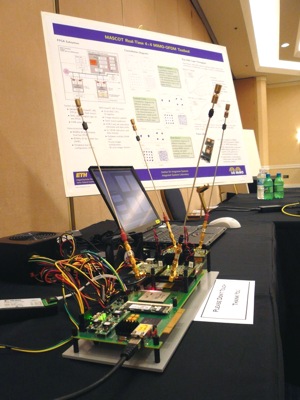 |
| One of the two testbed terminals
configured as station and set up for receiving the live
video stream. |
 |
| The testbed terminal configured as
station for live video reception accompanied by two
laptops: The left one served for playing the received video
stream using the VLC media player. Guess, what movie? Yes,
'Office Space'. The laptop on the right displayed the
corresponding statistics, e.g., instant and historic frame
error rates, and showed actual constellation diagrams of
received MIMO frames. |
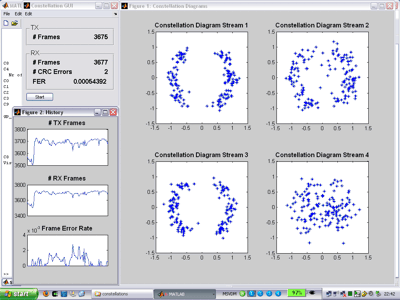 |
| Visualization of constellation
diagrams of received MIMO frames, in this case
four-stream MIMO reception with QPSK modulation, including
number of transmitted and received frames and instant and
historic frame error rates. Note that complex
hardware-software systems deserve time and dedication in
order to be put successfully into operation, as indicated
by the system clock at the lower right side of the screen
shot. |
ISCAS'09 Live Demonstration
Contest [Toc]
[Top]
At the time of the IEEE ISCAS'09 live demonstration contest in
May 2009, the MMSE-SQRD ASIC was completely deployed to the MIMO
testbed and fully operational in conjunction with different
tree-search-based MIMO detection schemes. As a consequence, we
were able to demonstrate for the first time advanced MIMO
detection schemes such as tree-search-based maximum likelihood
(ML) or near-ML MIMO detection. In the end, we have been awarded
the first place in this live demonstration contest.
 |
| Testbed setup at the IEEE ISCAS'09
live demonstration contest in Taipei, Taiwan, in May
2009: Three terminals of the real-time 4x4 MIMO-OFDM
testbed demonstrated four-stream MIMO wireless
communication including advanced tree-search-based MIMO
detection schemes. The constellation diagrams of the
received MIMO frames were instantly visualized with a
beamer attached to one of the VGA ports of the MMSE-SQRD
ASIC board. The picture shows four-stream MIMO
communication with QPSK modulation. |
 |
| One of the three MIMO testbed
terminals at the IEEE ISCAS'09 live demonstration
contest in Taipei, Taiwan. |
Testbed Deployment of the MMSE-SQRD ASIC
[Toc] [Top]
 |
| Block diagram of the MIMO
preprocessing architecture in the real-time MIMO-OFDM
testbed. The SQRD-based preprocessing architecture is
split into tree major parts: preprocessing top-level of the
PHY logic, FPGA-ASIC interface logic, and channel matrix
processing using two MMSE-SQRD ASICs. |
 |
| Custom-designed printed circuit
board for integration of the MMSE-SQRD ASIC in the
real-time 4x4 MIMO-OFDM testbed. In addition, the board
contains two video DACs with VGA output intended for being
used in the MIMO testbed as versatile debugging
infrastructure for different real-time aspects of MIMO PHY
internals and as corresponding visualization resource for
demonstration purposes. |
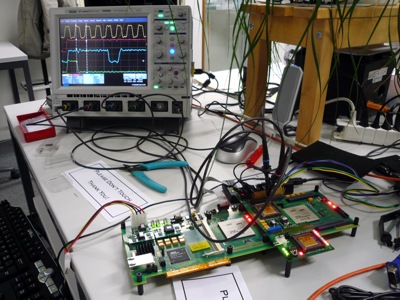 |
| Workspace showing the LeCroy
WaveRunner 204 MXi oscilloscope for assessment of clock
and control signals during initial bring-up of the
communication interface between MMSE-SQRD ASICs and the
XILINX Virtex-II Pro FPGA. |
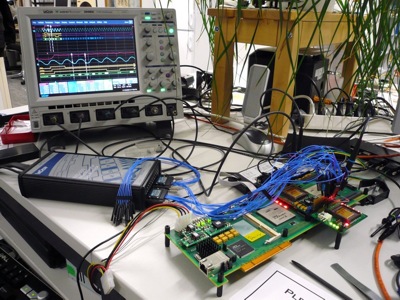 |
| Workspace showing the LeCroy
WaveRunner 204 MXi oscilloscope and the LeCroy
MS-500-36 mixed-signal extension for assessing
electrical and timing aspects of the FPGA-ASIC interface
during system-level deployment of the MIMO preprocessing
block. This sophisticated and powerful technical
solution from LeCroy greatly alleviated the challenging
task of achieving system-level timing closure for the MIMO
preprocessing block at a target clock frequency of
80 MHz, especially for the interface between ASICs and
FPGA. |
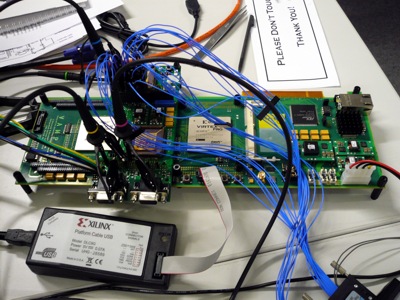 |
| Mixed-signal connections to the
MMSE-SQRD ASIC interface on the MIMO prototyping platform.
At the time of designing the PCB, I was not aware of the
importance of convenient debugging access by means of a
suitable high-density logic-analyzer connector. Instead, I
simply relied on extended standard headers interfacing the
MMSE-SQRD ASIC PCB with the VAMP board. The standard
headers also allowed to accomplish the job, but correctly
connecting approximately 27 unique logic-analyzer wires is
tedious and much more error-prone, and finally lasted more
than an hour... |
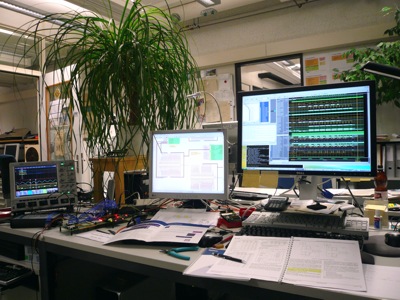 |
| Workspace showing interface
schematics in Altium Designer on the left screen and
RTL simulation results in Mentor ModelSim as
debugging reference on the right screen. |
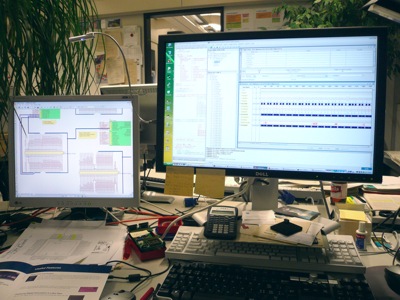 |
| Workspace showing interface
schematics in Altium Designer on the left screen and
XILINX ChipScope Pro in-system debugging results on
the right screen. ChipScope Pro is a versatile debugging
tool for the XILINX FPGA family by using synthesizable
debugging blocks requiring FPGA-internal resources for
capturing and storing digital signals. The captured signals
are afterwards transferred and visualized on a PC. In
principle, it is a low-cost logic analyzer specifically
tailored to FPGA development without the needs for external
connectivity to signals being debugged and the availability
of costly logic analyzers. In short, ChipScope Pro
represents a customizable debugging infrastructure for
XILINX FPGAs and usually employs FPGA-internal memory
resources for signal storage and the JTAG connection for
control and data transfer. |
Illustrating Material /
Posters [Toc]
[Top]
Below
some illustrating material about MIMO wireless communication,
including the two posters having been used at the Wintech'08 live
demonstration contest in San Francisco, USA. Note that the
posters of the ASIC collection show several student and research
ASICs from the Integrated Systems Laboratory of the ETH Zurich,
Switzerland, which are not related to my work.
- VLSI Circuits for
Wireless Communication / General MIMO Poster, Integrated
Systems Laboratory, ETH Zurich, Switzerland, April 2007
- Poster 1 & Poster 2 of ACM WinTech'08 Live
Demonstration Contest, Integrated Systems Laboratory, ETH
Zurich, Switzerland, Sept 2008
- Poster 1 &
Poster 2 showing
collection of various student and research ASICs for MIMO
wireless communication, Integrated Systems Laboratory, ETH
Zurich, Switzerland, Feb 2009
Last updated: 2013/06/01
[Toc] [Top]











